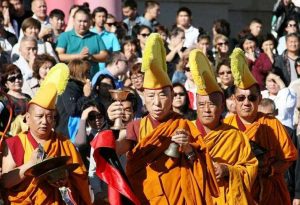The Buddha was born sometime around 563 or 480 BCE. The meaning of the word “buddha” is Awakened One. The Buddha is described as being “awakened” because he was in a long line of buddhas who rediscovered the path of the timeless Dharma. By revealing the Four Noble Truths and the Noble Eightfold Path, the Buddha showed us the way to destroy greed, hatred, and delusion.
According to the Buddhist teaching, humans are not superior or inferior by birth; rather, their actions determine whether they are “noble” (Pali: ariya). Therefore, the Buddha is said to have advised us to renounce all unwholesome deeds, to perform righteous deeds, and to purify our hearts in order to attain liberation.
According to the Buddha, we are our own saviors. We are responsible for our own salvation. He urged us to become enlightened on our own, although it is important for us to reach out to good teachers first. Our aim should be to eradicate greed, hatred, and delusion, while cultivating virtues such as compassion and loving-kindness. These provide the foundational habits for moving away from delusion and attaining enlightenment.
Although the Buddha taught us to be our own saviors, historians agree that he was already worshipped in his own lifetime. Early on, the Buddha was also known as the Bhagavat (the Blessed One). During his lifetime, many kings and noble persons were his fervent followers. Almost immediately after his death, his remains were interred in stupas across northern India. The most ancient sacred structures of Buddhism served dual mortuary and pilgrimage functions.
Fast forward 2,500 years, and Buddhists today revere and worship the Buddha by presenting foodstuffs, incense, and other offerings in front of Buddha images. Such actions are common in private households, during pujas, and during Buddhist festivals. Said festivals are mostly held on full-moon and new-moon days. In traditional Theravada countries, Buddhists go to the temple to perform puja. When they begin offering puja, they stand in queues, holding decorated plates of offerings on their heads. When performing these acts of devotion, the darkness of the mind is washed away and the consciousness is cleansed. These offerings are then made in a disciplined manner by sitting before a Buddha image. Prayer, chanting, Dhamma talks, and reciting the scriptures are variously structured around this community gathering before the Buddha image.
The advent of Buddha image worship
The heritage of the Buddha image has a long, complex history. The exact period when the worship of Buddha images was first introduced is murky. The causal connection between the worship of the Buddha and the appearance of the first Buddha images is also unclear. Were the sculptors of Gandhara and Mathura responding to market demand? Or were there already established standards for the creation of holy Buddhist images?
What is certain is that there was no provision for the worship of such images during the Buddha’s lifetime. As the Buddha himself willed, the non-personal aspect of Buddhism was accorded far more importance for at least several centuries in the scorching, poverty-stricken lands of northern India. Image worship was introduced later, with the emergence of the Buddha statue. The key to image worship was that for the first time, importance was placed not only on the teachings, but on the milestones of the Buddha’s life, deemed significant in themselves and worthy of respect and ritual. Mahayana and later Vajrayana Buddhism would both expand considerably on the theological rationale behind image worship.
So far, no Buddha statues have been discovered in ancient Buddhist art from the time of the Buddha’s demise to the founding of the Kushan Empire, which thrived in the first century CE. By the time of Ashoka the Great (r. c. 268–32 BCE), there was a thriving scene of Buddhist art, with artisans creating hundreds of stupas, pillars, monasteries, chaityas, railings, and inscriptions across India. Emperor Ashoka was a devout lay Buddhist, and he is recorded as having built a Buddha statue and various other monuments. But despite the emperor’s personal piety and the flowering of Buddhist art and architecture, statues, and more broadly, images of the Buddha continue to be absent in Mauryan aesthetics.
In the first century CE, during the reign of Emperor Kanishka (78–144 CE) in Central Asia and India, the most ancient Prajnaparamita or Perfection of Wisdom texts were circulated and transmitted. The revolutionary ideas discovered in these texts would lead to the establishment of Mahayana Buddhism. When the Indo-Greek or Gandhara kingdom was established in India’s northwest, Buddha statues started to become fashionable. Art from Gandhara and Mathura exhibits the early signs and iconography of Buddhist devotion—the notion that the Buddha’s presence can still be felt in his physical likeness.
The fruits of worshipping the Buddha
Is worshipping the Buddha image truly beneficial? Sceptics of devotional Buddhism declare the worship of inanimate Buddha statues a waste of time. Insentient Buddha images can never accept or appreciate worship, so how is it possible to accumulate merit? However, in the book The Questions of King Milinda, the Indo-Greek king Milinda and a monk called Nagasena arrive at a discussion about honoring the Buddha with the following analogy.
King Milinda said to the monk Nagasena: “Bhante Nagasena! The followers of different sects say that if the Buddha himself accepts worship, he would not attain Parinirvana. Surely, he is connected with this world; he exists somewhere in the world as an ordinary human being within the world. Therefore, his intended worship is in vain. And if he has attained Parinirvana, then he is disconnected from this world and has been discharged from all kinds of existences. Therefore, worshipping him is useless.”
(The Questions of King Milinda)
Nagasena replied that the Buddha has already attained Parinirvana. Since he lies outside of time and space, he can be worshipped while not being affected by worship. With the attainment of enlightenment, all his possessions and attachments were abandoned. The Buddha has attained final Nirvana. Therefore, this question can no longer arise.
As part of his explanation, Nagasena presented various analogies. One such exchange was as follows:
Nagasena: “Your Majesty! Does the world want all the seeds to germinate in the earth? Not at all. Your Majesty! But despite the reluctance of the earth, the seeds germinate in it.”
Milinda: “Yes, Bhante. This world is the base or shelter of all those seeds even if it does not want to. The earth helps the seed to germinate and grow. The seeds shelter the earth, germinate with the help of the earth, are established in strong roots and tangles, and are able to bear flowers and fruits by spreading their branches, fertilizers and branches.”
Nagasena: “Your Majesty! Then the followers of different sects prove themselves to be harmed and false in their doctrine that even if they do not accept the worship of the Buddha, the worship done to him is not in vain. Your Majesty! The Buddha does not accept anything as the world does not want or reject something. As the seed clusters germinate under the shelter of the earth, it is established in strong roots and tangles, the stems, fertilizers, branches spread and bear flowers. Such deities and human beings are established on the basis of strong auspicious roots by resorting to the physical metal gems and knowledge gems of the defunct Buddha. Your Majesty! For this reason, even if the Buddha does not accept worship, the worship performed for his purpose is successful, never in vain.”
(The Questions of King Milinda)
The worship of the Buddha was already a foregone conclusion in Early Buddhism. Still, the masters determined that it is necessary to worship properly, with right knowledge and awareness. While the ultimate goal is to transcend samsara and end rebirth, this is a long process, during which we can engage in various reverential, devotional practices such as offering gifts to the Buddha and creating and circulating Buddha images.
Many scholars have argued that worshipful actions like almsgiving and prayer are superstitious footnotes to a “purer” philosophical tradition. Yet the Questions of King Milinda, a thorough philosophical text on advanced ideas, teaches us the advantages and requirements of worship. The devotional or bhakti-like aspect of Buddhism was already present in Early Buddhism and manifested in its own unique way in the vehicles of Theravada, Mahayana, and Vajrayana. As long as the ultimate goal of liberation is not lost, the worship of the Buddha can actually facilitate and aid in that final objective.
Let us, in full awareness of the horizon of Nirvana, worship the Buddha in order to open the door to ultimate happiness.
See more
Milindapañha: The Questions of King Milinda (Access to Insight)
Related features from BDG
Taking Refuge
The Promise of Impermanence
Doing What Has to Be Done
Related news from BDG
Indian Delegation Brings Buddha Relics to Mongolia for Buddh Purnima Celebrations

















